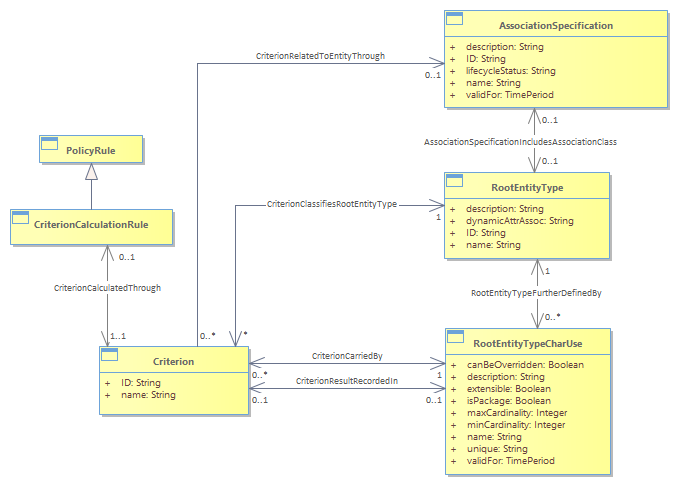Figure Sgt.01 - Criterion overview

|
Project:
|

Figure Sgt.01 - Criterion overview : Class diagram
The Criterion is the definition of information classifying an Entity from the model (represented by an instance of RootEntityType).<br/>A Criterion classifies only one RootEntityType, i.e. it helps grouping instances of only one Entity of the SID model.<br/>Examples:<br/><ul>
<li>the Criterion “Age” classifies Party (instance “Party” of RootEntityType)</li><li>the Criterion “Installation city” classifies Resource</li></ul> A Criterion might be<br/><ul> <li>either an existing information related to an Entity</li></ul> • in this case we need to specify where the information can be found <br/> • the Attribute carrying the Criterion information (RootEntityTypeCharSpec)<br/> • the Entity carrying the Criterion’s Attribute<br/> • and the Relationship between the Entity classified by the Criterion and the Entity where the Criterion can be found (AssociationSpecification)<br/><ul> <li>or an information that has to be calculated</li></ul> • in this case we need a rule that specifies when it has to be calculated and how to calculate the information (cf. CriterionCalculationRule)<br/> • the calculated information might be recorded or not. <br/> • If not, it is only used to evaluate the condition for the Criterion. <br/> • If yes, we need to specify where it has to be recorded <br/> • the Attribute carrying the Criterion information (RootEntityTypeCharUse)<br/> • the Entity carrying the Criterion Attribute (RootEntityType)<br/> • and the Relationship between the Entity concerned by the Criterion and the Entity where the Criterion is recorded (AssociationSpecification)<br/><i>Note:</i><br/><ul> <li><i>Only attributes carried by an Entity directly related to the Entity concerned by the Criterion can be specified to record the Criterion’s value.</i></li><li><i>As many relationships might exist between the Entity classified and the Entity carrying the Criterion attribute, we may need to specify which type of relationship is concerned (AssociationSpecification)</i></li></ul> For more information about RootEntity / RootEntityType pattern, refer to the Common guide book.<br/> |



